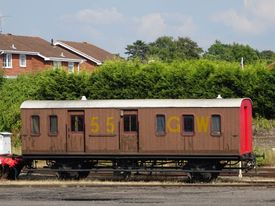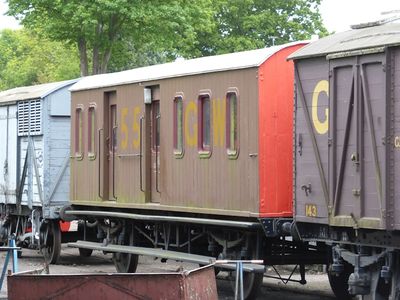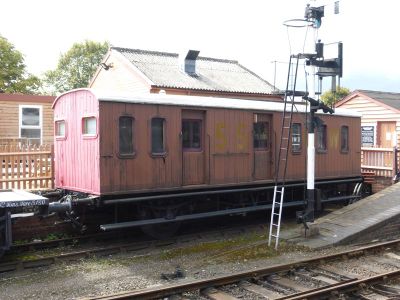GWR 55 Riding/Dormitory Van
| GWR 55 Riding/Dormitory Van | |
|---|---|
 GWR 55 at Kidderminster (2018) | |
| Built By | GWR Swindon |
| Status | Operational |
| Number | 55 |
| Other Numbers | DW 55 |
| History | |
| Built | 1908 |
| Diagram | n/a |
| Lot | 571 |
| Type | 4-w riding/dormitory van |
| Telegraphic code | n/a |
| 1973 | Arrived on SVR |
The tool and riding van pairs were stationed at GWR loco sheds. From there, they would be required to attend mishaps as fast as possible and were vacuum-braked to allow running at near express speeds.[1] They were painted in the NPCCS 'brown vehicle' livery normally used on goods wagons equipped for running in express passenger trains, although they were never used in that manner. Possibly the livery was chosen because breakdown trains travelling to emergencies and carrying a breakdown crew were rated as fast passenger trains.[2]
The tool vans and mess vans were built as wagon Lots, although they did not receive a Diagram number in either the wagon or coach Diagram book. They were built on old 4-wheeled or 6-wheeled coach under frames, as a result of which the chassis dimensions and details varied (of the SVR's four Mess vans, GWR 118 has a shorter wheelbase than GWR 55, GWR 89 and GWR 162). The mess vans were fitted with full length bunks for use as sleeping accommodation when required. The GWR Diagram describes the 3-window end as the 'Mens compartment' and the two-window end as the 'Officials compartment', separated by the central 'Goods compartment'. As built the vans were gas-lit and included stoves for heating and cooking. The interconnecting door was at the 'Mens compartment' end, while the heating stove was at the far end of the 'Officials compartment'[2].
Contents
GWR 55 in service
55 was built at Swindon in 1908 as part of Lot 571. Initially it was allocated to Trowbridge and later to Westbury, both in Wiltshire.[3] During the BR era it carried the Departmental number DW55[4].
GWR 55 in preservation
55 arrived on the SVR from Tyseley on 24 November 1973, having been acquired by the GWR 813 Preservation Fund. Since that time the majority of its time had been spent at Bewdley Down Yard in various static roles.
After GWR Pannier 7714 arrived on the SVR in March 1983, its restoration was carried out at Bewdley. 55 was used as a workshop during the restoration, and was repainted by the '7714 team' in spring 1984.[5]
In summer 2016, 55 was moved from Bewdley to Hampton Loade for temporary use as volunteer accommodation, taking the place of GWR 2426 Toplight Full Third. In November 2016, it was moved to Kidderminster for use as a mess room during the Santa services. By July 2017 it had returned to Bewdley. The main picture (top right) shows 55 during another visit to Kidderminster in summer 2018. The 'Mens compartment' is to the right and the interconnecting door is just visible in the end of the vehicle.
After returning to Bewdley, 55 was again located in the yard, although the picture below shows it having been moved to the bay platform during a rearrangement of stock. This view shows the 'Officials compartment' end of the vehicle.
In October 2021 the 813 Fund announced that 55 was to move back to the bay platform to become the new GWR 813 Fund sales van.

